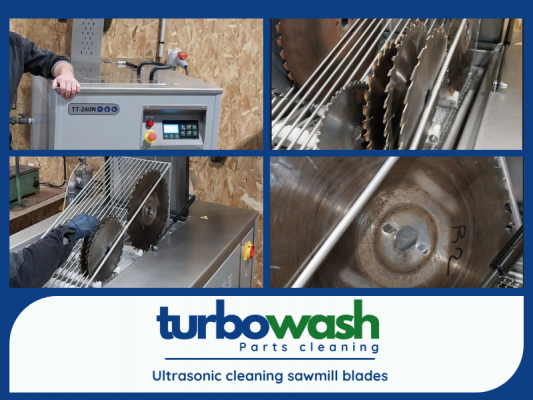Ultrasonic cleaning and sharpening of sawmill blades are advanced methods used to improve the performance, longevity, and cutting efficiency of the blades. Here’s a breakdown of how these processes can be applied to sawmill blades:
1. Ultrasonic Cleaning of Sawmill Blades
Ultrasonic cleaning uses high-frequency sound waves (typically between 20-40 kHz) to create cavitation bubbles in a liquid cleaning solution. When these bubbles collapse, they generate intense localised energy, which cleans the surface of objects like sawmill blades very effectively.
Process Overview:
- Preparation: Blades are first pre-cleaned by wiping off large debris or dirt.
- Cleaning Solution: The blade is immersed in a tank filled with water and a specialised cleaning solution (usually alkaline or acidic, depending on the material).
- Ultrasonic Cavitation: An ultrasonic transducer generates sound waves in the solution, creating cavitation bubbles that remove dirt, resin buildup, sap, oils, or other contaminants adhered to the blade’s surface.
- Rinsing and Drying: After ultrasonic cleaning, the blade is rinsed in fresh water to remove any remaining cleaning solution and then dried thoroughly to prevent corrosion.
Benefits of Ultrasonic Cleaning:
- Thorough Cleaning: Reaches hard-to-clean areas, like teeth and gullets of the saw blade, ensuring no residue is left behind.
- Non-Abrasive: Gentle on the blade’s surface, preserving its finish and reducing the risk of damage during cleaning.
- Improved Efficiency: Clean blades cut better and with more precision, reducing downtime and maintenance costs.
- Reduced Wear: Cleaner blades experience less friction during cutting, increasing their operational lifespan.
2. Sharpening Sawmill Blades Using Ultrasonics
While ultrasonic cleaning is well established, ultrasonic sharpening is a more specialised application. It involves using high-frequency vibration to enhance the sharpening process of sawmill blades. Although ultrasonic sharpening is less common for large industrial saw blades, there is potential for its use in fine sharpening tasks.
Process:
- Ultrasonic Vibration-Assisted Sharpening: In this method, high-frequency vibrations are applied to a sharpening tool, typically a grinding stone or file. The vibration allows the sharpening tool to make more controlled and effective contact with the blade’s cutting edge, resulting in a finer, sharper edge with less effort.
- Manual or Machine-Assisted: This can be done manually or with automated machines that incorporate ultrasonic technology for precision sharpening.
Benefits of Ultrasonic Sharpening:
- Precision: Ultrasonic vibrations allow for highly controlled material removal, resulting in sharper edges with minimal burrs.
- Efficiency: Faster and more consistent sharpening compared to traditional methods.
- Edge Retention: The sharpness achieved through this method may result in better edge retention due to the uniformity of the sharpening process.
Ultrasonic cleaning is a highly effective way to maintain sawmill blades, enhancing their performance and lifespan by thoroughly removing contaminants without causing damage. Ultrasonic sharpening, while less common, offers precise and efficient blade sharpening. In combination, these technologies can significantly improve the overall productivity and efficiency of sawmill operations.
We’re committed to providing advanced, efficient, and eco-friendly solutions to meet your cleaning needs. For further inquiries or to make a purchase, feel free to contact us at +353 (0) 1 6978069 or via email at info@turbowash.ie.

